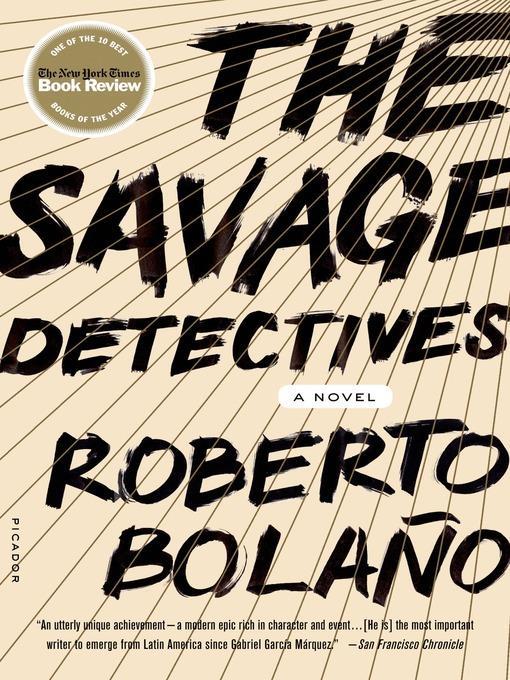
The Savage Detectives
A Novel
کتاب های مرتبط
- اطلاعات
- نقد و بررسی
- دیدگاه کاربران
نقد و بررسی

Starred review from December 11, 2006
This novel—the major work from Chilean-born novelist Bolaño
\t\t (1953—2003) here beautifully translated by Wimmer—will allow English
\t\t speaking readers to discover a truly great writer. In early 1970s Mexico City,
\t\t young poets Arturo Belano (Bolaño's alter ego and a regular in his
\t\t fiction) and Ulises Lima start a small, erratically militant literary movement,
\t\t the Visceral Realists, named for another, semimythical group started in the
\t\t 1920s by the nearly forgotten poet Cesárea Tinajero. The book opens with
\t\t 17 year-old Juan García Madero's precocious, deadpan notebook entries,
\t\t dated 1975, chronicling his initiation into the movement. The long middle
\t\t section—written, like George Plimpton's Edie, as a set of anxiously vivid testimonies from
\t\t friends, lovers, bystanders and a great many enemies—tracks Belano and Lima
\t\t as they travel the globe from 1975 to the mid-1990s. There are copious, and
\t\t acidly hilarious, references to the Latin American literary scene, and one
\t\t needn't be an insider to get the jokes: they're all in Bolaño's
\t\t masterful shifts in tone, captured with precision by Wimmer. The book's moving
\t\t final section flashes back to 1976, as Belano, Lima and García Madero
\t\t search for Cesárea Tinajero, with a young hooker named Lupe in tow.
\t\t Bolaño fashions an engrossing lost world of youth and utopian ambition,
\t\t as particular and vivid as it is sad and uncontainable.

January 1, 2007
The author of several novels, plus short stories and poetry, the Chilean-born Bolaño was a member of the iconoclastic infrarealism movement, a minor anti-magic realism movement featured in his work as visceral realism. Bolaño died prematurely three years ago of liver disease, but with the publication of these two capable translations, he seems to be achieving far greater fame posthumously than he did when aliveat least in North America. In "Amulet", Uruguayan poet Auxilio Lacouture leaves her homeland in 1965 to settle permanently in Mexico, where she leads a bohemian existencehousekeeping for exiled Spanish poets León Felipe and Pedro Garfías, volunteering at the National Autonomous University of Mexico's Faculty of Philosophy and Literature, and performing other odd jobs for pay at the university. She also strikes up a serious friendship with Arturo Belano (the author's alter ego) and other artists. Eventually, Auxilio gets caught up in the 1968 riots at the university, finding herself sequestered on campus for almost two weeks; the bulk of this monolog novelette recounts her ordeal as her meandering thoughts gradually move from harsh reality to a startling vision. We also come to realize that the author has been teasing us with Auxilio's opening lines about telling a horror story, which is not what we finally get. The work is short, episodic, and loosely connected, almost as if the author had several disparate elements on his plate that he wanted to make into a whole, unified by the presence of the main character.
Far more ambitious, and to some extent more successful, "The Savage Detectives" is a sprawling yet well-intentioned work. The opening and closing sections consist in the diary, written from November 2, 1975, to February 15, 1976, of fictitious poet García Madero, who, along with fellow poets Arturo Belano and Ulises Lima (Bolaño and compatriot Mario Santiago in disguise), as well as a fugitive prostitute, set out in quest of Mexican poet Cesárea Tinajero, who apparently disappeared in the Sonoran Desert in the 1920s. The bulk of the framed novel, however, is the dense, disjunctive middle portion, in which a panoply of characters over several continents narrate through their diary entries their connection to the main characters and what happened to them during the 20 years following the Sonoran adventure. In a creatively interesting twist, one of these characters is "Amulet"'s Auxilio Lacouture. The journey for all, including the reader, may prove arduous, but as a picaresque road novel, coupled with successful character creation, intriguing experimentation, and a unique premise, it provides a rewarding reading experience. For both public and academic libraries. [For "The Savage Detectives", see Prepub Alert, "LJ" 12/06.]Lawrence Olszewski, OCLC Lib., Dublin, OH
Copyright 2007 Library Journal, LLC Used with permission.

January 1, 2007
This is the posthumously published English translation of the prizewinning novel that made celebrated Chilean Roberto Bolano famous. This highly stylized novel is ostensibly about two poets, leaders of the Mexican visceral realist literary movement, and their search for an obscure icon of the movement and its repercussions. The book spans a decade and follows the poets from Mexico City to the Sonoran Desert, Guatemala, Barcelona, Paris, Israel, Congo, Liberia, and the U.S. The narrative becomes secondary to the voices of the people who meet these poets as this long novel told through the personal stories--some humorous, some inscrutable, some tragic--of the eclectic assortment of characters they encounter on the way becomes less about the search and more about literature and language. For readers interested in a straight narrative, this book will disappoint, but those who enjoy voice and character will find much to satisfy them. As one of the characters notes, "Well. In Latin America these things happen and there's no point giving yourself a headache trying to come up with a logical answer when there is none."(Reprinted with permission of Booklist, copyright 2007, American Library Association.)

























دیدگاه کاربران